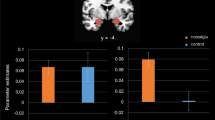Abstract
Our memories of misdeed become less clear over time; this is known as unethical amnesia. Recently, Kouchaki and Gino (Proceedings of the National Academy of Sciences USA, 113(22), 6166-6171, 2016) explained that unethical amnesia occurs because of the psychological distress and discomfort such illegal acts cause (psychological mechanism). Notably, unethical amnesia has two components: cognitive as well as emotion. Authors have not explained the possible cognitive-emotional and neural mechanisms underlying unethical amnesia. To get the complete picture of unethical amnesia, I firmly believe that along with psychological mechanisms, it is essential to explain underlying cognitive-emotional and neural mechanisms, which is the primary focus of this paper. Together, it will give real insight to the reader to understand this phenomenon.
Similar content being viewed by others
References
Anderson, M. C., & Green, C. (2001). Suppressing unwanted memories by executive control. Nature, 410, 366–369.
Bergström, Z. M., Anderson, M. C., Buda, M., Simons, J. S., & Richardson-Klavehn, A. (2013). Intentional retrieval suppression can conceal guilty knowledge in ERP memory detection tests. Biological Psychology, 94(1), 1–11.
Bořil, H., Boyraz, P., and Hansen, J. H. L. (2009) Towards multimodal driver’s stress detection, in Proc. 4th Biennial Workshop DSP In-Vehicle Syst. Safety, Dallas, TX, Jun. 25–27.
Butler, A. J., & James, K. H. (2010). The neural correlates of attempting to suppress negative versus neutral memories. Cognitive Affective and Behavioral Neuroscience, 10(2), 182–194.
Depue, B. E., Curran, T., & Banich, M. T. (2007). Prefrontal regions orchestrate suppression of emotional memories via a two-phase process. Science, 317(5835), 215–219.
Gupta, R. (2011). Attentional, visual, and emotional mechanisms of face processing in Williams syndrome. Frontiers in Behavioral Neuroscience, 5, 18. https://doi.org/10.3389/fnbeh.2011.00018.
Gupta, R. (2012). Distinct neural systems for men and women during emotional processing: a possible role of attention and evaluation. Frontiers in Behavioral Neuroscience, 6, 86. https://doi.org/10.3389/fnbeh.2012.00086.
Gupta, R. (2016). Commentary: neural control of vascular reactions: impact of emotion and attention. Frontiers in Psychology, 7, 1613. https://doi.org/10.3389/fpsyg.2016.01613.
Gupta, R., & Deák, G. O. (2015). Disarming smiles: irrelevant happy faces slow post-error responses. Cognitive Processing, 16(4), 427–434.
Gupta, R., & Kar, B. R. (2008). Interpretative bias: indicators of cognitive vulnerability to depression. German Journal of Psychiatry, 11, 98–102.
Gupta, R., & Kar, B. R. (2012). Attention and memory biases as stable abnormalities among currently depressed and currently remitted individuals with unipolar depression. Frontiers in Psychiatry, 3, 99. https://doi.org/10.3389/fpsyt.2012.00099.
Gupta, R., & Raymond, J. E. (2012). Emotional distraction unbalances visual processing. Psychonomic Bulletin and Review, 19(2), 184–189.
Gupta, R., & Srinivasan, N. (2009a). Emotion helps memory for faces: role of whole and parts. Cognition and Emotion, 23(4), 807–816.
Gupta, R., & Srinivasan, N. (2009b). Cognitive neuroscience of emotional memory. In H. Chatterjee & E. N. Chatterjee (Eds.), Advances in developmental neuroscience and imaging (pp. 91–96). New Delhi: Anamaya Publishers.
Gupta, R., & Srinivasan, N. (2015). Only irrelevant sad but not happy faces are inhibited under high perceptual load. Cognition and Emotion, 29, 747–754.
Gupta, R., Hur, Y., & Lavie, N. (2016). Distracted by pleasure: effects of positive versus negative valence on emotional capture under load. Emotion, 16, 328–337.
Hu, X., Bergström, Z. M., Bodenhausen, G. V., & Rosenfeld, J. P. (2015). Suppressing unwanted autobiographical memories reduces their automatic influences evidence from electrophysiology and an implicit autobiographical memory test. Psychological Science, 26(7), 1098–1106.
Kouchaki, M., & Gino, F. (2016). Memories of unethical actions become obfuscated over time. Proceedings of the National Academy of Sciences USA, 113(22), 6166–6171.
Martiny-Huenger, T., Gollwitzer, P. M., & Oettingen, G. (2014). Distractor devaluation in a flanker task: object-specific effects without distractor recognition memory. Journal of Experimental Psychology: Human Perception and Performance, 40, 613–625.
Pessoa, L. (2009). How do emotion and motivation direct executive control? Trends in Cognitive Sciences, 13(4), 160–166.
Srinivasan, N., & Gupta, R. (2010). Emotion-attention interactions in recognition memory for distractor faces. Emotion, 10, 207–215.
Srinivasan, N., & Gupta, R. (2011). Global-happy and local-sad: perceptual processing affects recognition of distractor emotional faces. Quarterly Journal of Experimental Psychology, 64, 425–433.
Srivastava, P., & Srinivasan, N. (2010). Time course of visual attention with emotional faces. Attention, Perception and Psychophysics, 72, 369–377.
Author information
Authors and Affiliations
Corresponding author
Ethics declarations
Conflict of Interest
The author declares that there is no conflict of interest.
Rights and permissions
About this article
Cite this article
Gupta, R. Possible Cognitive-Emotional and Neural Mechanism of Unethical Amnesia. Act Nerv Super 60, 18–20 (2018). https://doi.org/10.1007/s41470-018-0017-4
Received:
Accepted:
Published:
Issue Date:
DOI: https://doi.org/10.1007/s41470-018-0017-4




